Blogs
Guide to Conducting Live Virtual Press Conferences That Actually Work

We need to be honest with ourselves and admit that most virtual press conferences feel like watching paint dry over Wi-Fi. Awkward silences, bad lighting, dropped signals, and talking points that land flat. If that’s your setup, you’re not informing the public—you’re losing them. That’s why this guide to conducting live virtual press conferences isn’t just about tools. It’s about presence, control, and message discipline in a digital-first world.
Whether you’re launching a political campaign, responding to breaking news, or rallying community support, the virtual podium is now your stage. And trust me, I’ve been there. From mic-drop moments with lawmakers to digital rallies with millions watching, I’ve learned what works—and what falls apart under pressure.
So here it is: a step-by-step breakdown to help you own the screen like the message matters.
Start With Intent, Not a Calendar Invite
Before you even schedule your press conference, get clear on why you’re hosting it—and what outcome you want. Too many people hold virtual events just to say they did. That’s not a strategy. That’s noise.
Ask yourself:
- Are you trying to break news?
- Do you want to control a narrative?
- Are you amplifying a community voice that’s been ignored?
Everything that follows, who you invite, what platform you use, even your visual setup, should serve that purpose. In my own work at Call to Activism, every virtual press event has a mission. Whether it’s defending democracy or taking a stand on disinformation, we design the event around outcomes, not optics.
That’s the first step in this guide to conducting live virtual press conferences: start with strategy, not tech.
Choose the Right Format and Platform
Zoom is not always the answer. Sometimes it’s the problem. Your format should match your audience and your goals.
Here’s a breakdown I often follow:
- Zoom/Webex/Google Meet – Great for controlled invite-only pressers with Q&A
- YouTube Live – Best for public-facing transparency and media archiving
- Twitter/X Spaces or IG Live – Useful for rapid-response messaging with social engagement
- Company Webcast or ON24 – Ideal for larger events with built-in registration, branding, and analytics
Whichever platform you choose, master it. Test it. Know how to spotlight a speaker, mute participants, record video, enable captions, and manage screen-sharing without fumbling. Your tech shouldn’t distract from your message.
Craft Your Message Like It’s a Soundbite Waiting to Happen
The press isn’t there to capture your 20-minute policy overview. They want the quote. The one line that sums up your stance and makes the front page—or hits TikTok.
So, your core message?
Make it bold, short, and repeatable. This is something I build into every single digital event I lead. You want a “mic drop moment” because that’s what moves from the conference to the conversation. Our interviews with politicians went viral because we didn’t just throw out talking points. We reverse-engineered the moments.
That’s what separates a good virtual press event from a forgettable one.
Plan the Flow: Roles, Timing, and Visuals
Let’s be real—people click away fast. A well-run virtual press conference should:
- Start on time
- Introduce who’s speaking and why
- Deliver key remarks within 5–7 minutes
- Transition to media Q&A or community input smoothly
- End with a call to action or summary statement
Also, keep visuals sharp and simple. A campaign banner is behind you. A title screen if you’re screen-sharing. No visual clutter, no pixelated headshots, and for the love of media discipline—test your lighting and audio. One of the most practical (yet often overlooked) tips in this guide to conducting live virtual press conferences is to plan as if people can—and will—tune out at any moment.
Don’t give them a reason to.
Engage the Press Before, During, and After
Virtual doesn’t mean distant. Reach out to journalists beforehand with:
- A clear, concise press release
- High-res images or quotes they can use
- Login instructions or livestream links
During the event, make it easy for them to ask questions. Use the chat function or set up a real-time Google Form to queue submissions. After the event, follow up. Provide a recap email, time-stamped transcript, and links to replay. Journalists are busy. Make it easy for them to cover you accurately.
I do this with every high-profile guest we host—from Elizabeth Warren to Nancy Pelosi—because follow-up is how you keep the story going once the live feed ends.
Control the Narrative, But Stay Authentic
Yes, stay on message. Yes, redirect when needed. But don’t turn into a political chatbot. Speak like a human being with urgency, clarity, and conviction. Especially in virtual spaces, people sniff out rehearsed rhetoric. They want to know you’re showing up, not just phoning it in.
The strongest digital voices today are the ones who sound informed and real. If you want your message to last beyond the livestream, let them see the fire behind your facts.
Your Digital Stage Is Your Power
If you’re still wondering how to hold a press conference that hits, don’t overthink it, just plan it like it matters. Because it does. In a time when people distrust institutions and tune out spin, your voice, when used well, is your greatest asset.
This guide to conducting live virtual press conferences isn’t about being polished. It’s about being prepared. So when you go live, do it with purpose, power, and presence. I’ve seen what happens when we show up ready. That’s when the headlines follow.
